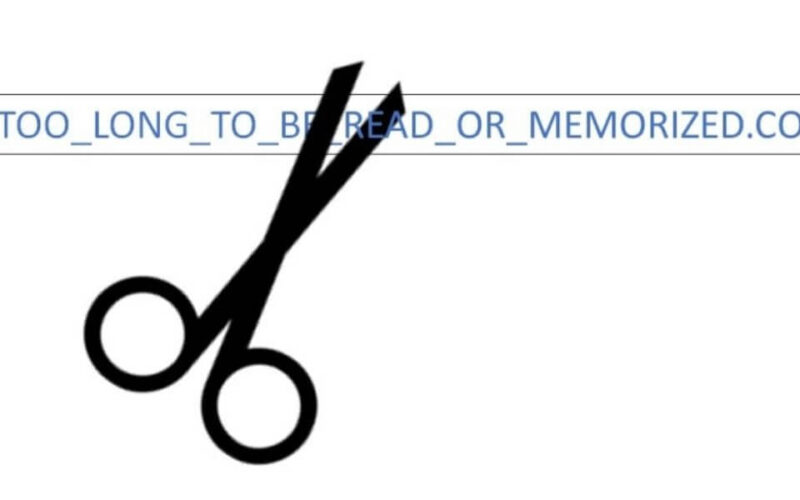In this article, we will be explaining a relatively under-utilized monetization strategy of paid link shorteners.
We are going to also take a comprehensive look at what link shortening is, the various services available to users; including the best ones, and how sites are making money from link shortening services.
What do bloggers, digital marketers, and website owners all have in common? The simple answer is the desire to maximally monetize their content and audiences.
When this is achieved, the profit margin increases. While contents and audience behavior differs, the value of the traffic they create remains the real driving factor for any online business irrespective of the niche, demography or country.
The more common and popular methods of monetizing online businesses are through the selling of ad spaces, affiliate product marketing, or even personalized digital products among many others.
It’s important to also know that monetization methods work differently. Some methods require constant work for continual optimization, others are more or less passive requiring lesser work time and some are custom-built for specific websites.
Does that mean online business owners can’t combine monetization methods? No. Online business owners are enjoined to creatively combine different methods and use them concurrently.
It is advised that they test different combinations of strategies to see what works best for their business.
In this article, we will be explaining a relatively under-utilized monetization strategy of paid link shorteners.
We are going to also take a comprehensive look at what link shortening is, the various services available to users; including the best ones, and how sites are making money from link shortening services.
Without much delay, let’s get started.
What are Link Shorteners?
Link shortening is a technique on the Web in which a URL can be made substantially shorter and still direct to the required page. In other words, link shortening means literarily reducing the length of links.
The link shortening process works on the premise that users provide a full website URL to a link shortening service, which then converts the link and instantly provides user with a short URL redirect that sends audiences to your requested site location.

For instance, you find yourself on a social media site with limited number of character input for sharing with your audience such as Twitter. You soon realize that your link is longer than the required amount of character. What do you do? Well, Twitter has an automatic link shortening service which actively reduces the length of the inputted link thereby saving space and allowing you add more information to share with your audience. An example is illustrated below:

Shortened to

While this is automatically done by Twitter, other social media sites might not have this service. Therefore, the need to find and use a suitable link shortening service arises. But first, ask yourself, why do i need to shorten links?
Brief History of Link Shortening
The earliest known mention of link shortening was a reference to an American patent, which describes it as “…a system, method and computer program product for providing links to remotely located information in a network of remotely connected computers”.
The patent was filed in September 2000; while the patent was issued in 2005 with the first notable URL shortening service, TinyURL, being launched in 2002. Subsequently, other major players in the online world started off their own shortening services.
Twitter initially used TinyURL for shortening purposes before moving on to bit.ly and would eventually develop its own URL shortening service, t.co.
On 14 August 2009 WordPress announced the wp.me URL shortener for use in reference to any WordPress.com blog post. By November 2009, shortened links on bit.ly were accessed 2.1 billion times.
On December 14, 2009, search engine giant, Google, announced a service called Google URL Shortener at goo.gl, which originally was only available for use through Google products (such as Google Toolbar) and extensions for Google Chrome. On 21 December 2009, Google introduced a YouTube URL Shortener, youtu.be.
Why Use A Link Shortener?
Aside from the fact that link shorteners shorten your URL, you might also want to consider other reasons why you need them.
Saving space and beautify ugly long links:
arguably the most common reason for using link shorteners is to simply shorten very long and cumbersome links. Long links are aesthetically unpleasing as it includes many descriptive attributes. This can result in URLs that are hundreds of characters long with complex character patterns.

Such URLs are difficult to memorize type out or distribute. As a result, long URLs must be copied and pasted for reliability. Therefore shortened links are more suitable and convenient.

This holds true when using social media sites, text messaging, or print media.
Gain advanced tracking and statistics:
One awesome benefit to shortening links before sharing on different platforms is having the ability to track how many clicks you are actually getting.
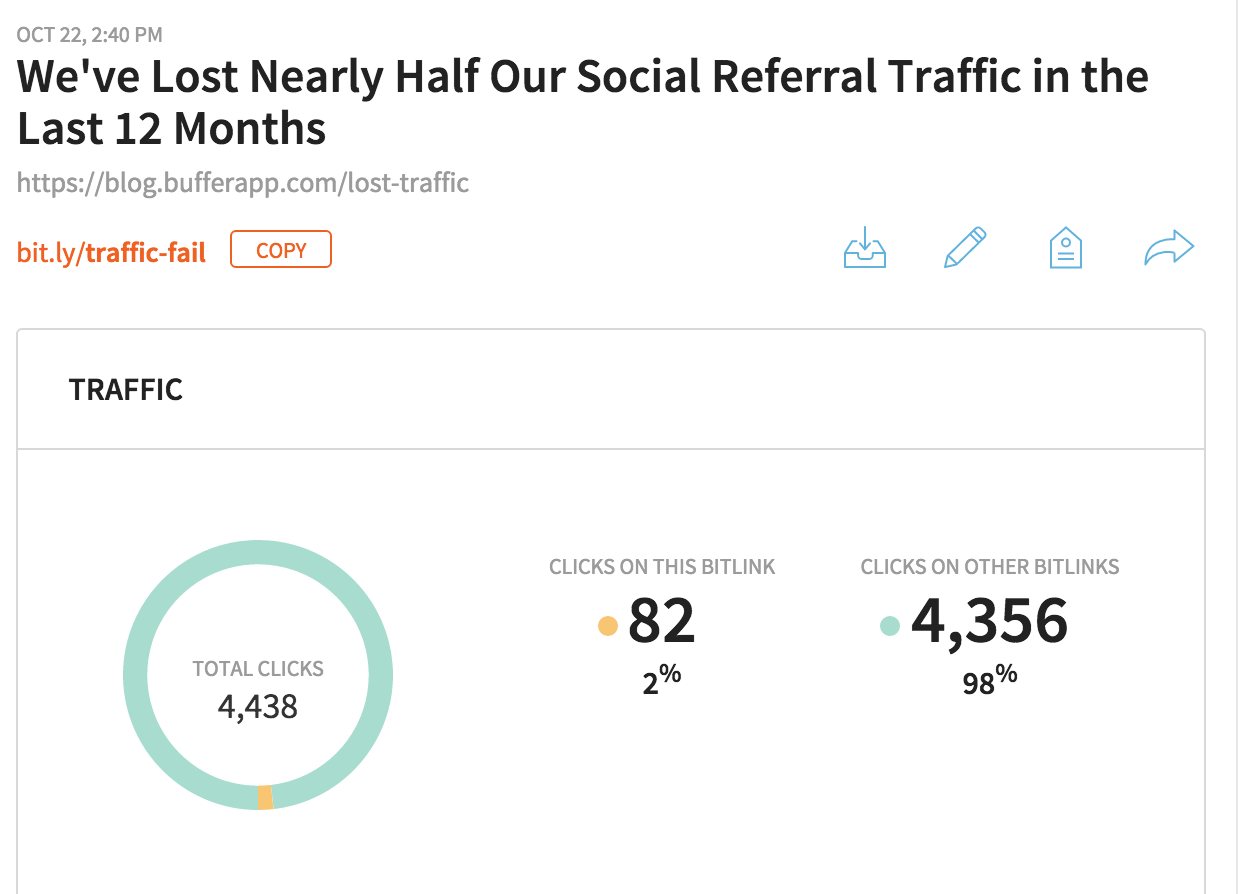
And from where those clicks came, impressions and a range of other track-able data.
Hide affiliate links and target URLs:
If you are into Affiliate marketing, this is a great way of making extra bucks. When audiences see a shortened URL, they normally don’t know where they will land until after clicking. So you can mask information from the public to promote an affiliate offer or link to another site with a referral ID. This is a classic example of why online businesses are using link shortening.
Linking to blocked websites and content:
Often, social networks like Facebook and Twitter block websites for various reasons. One way to bypass this is to use link shortening services.
Making money:
With respect to the scope of this article and in addition to the aforementioned benefits, this has to be the most important reason for using link shortening. Online business owners can make money by using link shortening services to display adverts in between the visitor process, thus creating an avenue to generate extra revenue. Cool!!
Cons of Using Link Shortening Services
Short URLs often bypass the intended use of top-level domains and as such are bound to be abused. We highly recommended new users should familiarize themselves with the many demerits of using such services.
The greatest drawback a user of these services will face is convincing audiences to feel safe and secured when using your shortened links.
Blocking and Banning:
if you intend to share your shortened URLs on other websites, it is a good practice to know forehand if such sites accept shortened links. Some websites prevent short, redirected URLs from being posted.
In April 2009, TinyURL was reportedly blocked in Saudi Arabia. Yahoo! Answers also blocks postings that contain TinyURLs and Wikipedia does not accept links by any URL shortening services in its articles. Likewise, the Reddit community strongly advises against the use of URL shortening services for link submissions.
The major reason for this is because shortening services disguise the original domain name.
Linkrot:
The convenience offered by URL shortening also introduces potential dangers. Short URLs, for example, will be subject to linkrot if the shortening service stops working; all URLs related to the service will become broken.
It is a known fact that many existing link shortening services may not have a sustainable business model in the long term.
Abuse:
URL shortening can be used by spammers or for illicit internet activities. As a result, many have been removed from online registries or shut down by web hosts or internet service providers.
Google’s URL-shortener discussion group has frequently included messages from frustrated users reporting that specific shortened URLs have been disabled after they were reported as spam.
- A study in May 2012 showed that 61% of URL shorteners have shut down (614 of 1002). The leading cause cited was abuse by spammers.
Privacy and security:
A privacy problem for many services’ shortened URL format is that the links are small enough that it is vulnerable to brute-force search. Many people use URL shorteners when they share links to private content. Web services like Google Maps have offered automatic generation of shortened links for driving directions that can reveal personal information like home addresses and sensitive destinations like clinics for specific diseases, addiction treatment centers, correctional and juvenile detention facilities, payday and car-title lenders etc. Many URL redirection services are also susceptible to being added to spam blacklists.
You now have an idea of what link shortening is, why you need to use link shortening services, its pros alongside its associated cons. As we said before, the most important reason for using a link shortening service is to increase earnings. That said, it is important to note that not all link shorteners will pay you as they all do not offer monetization option.
For the sake of this article, we will be focusing entirely on Paid Link Shorteners that give users all the necessary functions of normal shorteners along with the added option to make money.
Let’s move on to the money-making aspect.
How Paid Link Shorteners Work
In general, link shortening services work on the principle of redirect, using either the 301 redirect or 302 redirect.
The bottom line is that when you share a link, you have no idea where or how it will spread, but if it does, why not ensure your site gets the right credit for it?
Not sure of what Redirect code a service provider is using, users can enter the short URL into the URL box of Rex Swain’s HTTP Viewer, deselect the “Auto-Follow” box and submit. Then check to see what code is reported.
The numbers 301 and 302 stands for the code a web server issues to a browser or search engine when a URL is requested.
301 Redirect
A 301 redirect says that the URL requested (the short URL) has “permanently” moved to the long address. Since it’s a permanent redirect, search engines finding links to the short URLs will credit all the clicks to the long URL.
If you’re hoping that links you share will generate click credit for your website, you want a service that issues a 301 redirect. Also keep in mind that while 301s might be issued today, a shortening service could shift to a 302 redirect at any time.
302 Redirect
In contrast, a 302 redirect signifies that the requested URL has “temporarily” moved to a long address. If that’s issued, search engines assume that the short URL is the “real” URL and just temporarily being pointed elsewhere.
That means click credits do not get passed on to the long URL.
Criteria for Choosing a Link Shortening Service
Choosing a link shortening service can prove to be a tedious task. Many factors have to be considered. Both immediate and future scenarios also must be thought of.
Feeling confused? Don’t worry, we will provide you with some useful and helpful tips to ease your decision-making.
Tracking
Have people been clicking on the URLs that you share? Services like Google Analytics will show you traffic and where they come from.
What if you want to investigate further than it allows? In comes your Link shortening service.
A number of URL shortening services provide tracking statistics, which in turn range from basic to extensive reporting.
It makes sense to select a service that provides tracking. It’s better to have data and not need it than need it and not having it.
In my opinion, tracking is an important feature. That’s why services that offer tracking stats are highly rated and widely popular than those lacking it.
Stability
Nothing is more disheartening than sharing a link using Link Shorteners and then having people tell you that the link isn’t working, because the URL shortening service has gone down.
Unfortunately, there is no regular metrics of which the stability of a service can be measured. Our opinion is that those gaining funding and partnerships are more likely to solve capacity problems than others.
Aside from short-term stability issues, there’s also long-term consideration. What happens if a service shuts down, just as Zi.ma did? If a service goes down permanently, it takes down all those links that were passing along credit to your site with it.
Although in the case of Zi.ma, fortunately, Kl.am was able to keep those links working. But they could just have easily been lost forever.
Some services such as TinyURL have been around since 2002, so it has some stature in the stability area.
Others like Bit.ly have in the recent past raised $2 million in funding, which suggests it has some people willing to sink money into its future. But neither stature nor investment is a guarantee of long-term stability and success.
Total character size
Another factor to consider is just how small you can shrink your link. The first step in keeping URL size down is if the domain used by the URL shortening service itself is small.
For example, popular service TinyURL has the domain of tinyurl.com, which equals a total of 11 characters.
But another service K1.am comes in at only 4 characters. It becomes obvious that TinyURL will always be at a disadvantage over k1.am because there’s simply no way for it to reduce its domain name.
Conversely, after the domain name comes the concluding part of the URL, the “path” portion or what on a normal website would be referred to like the page name.
The path size for shortening services typically ranges from 3 to 6 characters. If you really want to stay small on character counts, find a service that uses a short 3 character path.
It’s important to bear in mind that over time, even services offering short paths won’t be able to maintain this.
That’s because there are only so many possible 3 character combinations that can be used (you can find a suitable tutorial on this at is.gd).
When those have all been exhausted, a shortening service either has to expand the number of characters used or recycle old combinations.
Recycling URLs
Can services recycle URLs? Yes, they can. Link Shorteners can reissue a URL that has been used before.
In general, if it’s essential to save every character, go with a service that currently uses fewer characters for the path.
Otherwise, seek out a service that keeps its domain as short as possible. But as I’ll say, a short domain doesn’t deduct from other factors you may wish to consider.
If you prefer the very smallest URL possible, then it is wise to consider the total characters. However, keep in mind that any service offering short 3-4 character paths presently will, if and when it becomes popular, grow to using 6-7 character paths.
On the other hand, if you’re considering a long-term scenario, especially with tracking in mind, then looking at the total count figure is bad, as this will most likely change over time. Instead, the domain character count should be considered.
Custom or Vanity URLs
Ordinarily, Link Shorteners make up a random path for your URLs, for example,/7X3 or /pxq02e2 and other boring character combinations you must have seen.
Interestingly, some services allow users to override this setting, so that your path can have a “custom” or “vanity” ending.
That means you can have a custom name for your URL. Examples are these links that lead to Search Engine Land via different shortening services:
- http://bit.ly/seland
- http://cli.gs/seland
- http://kl.am/seland
- http://sn.im/seland
- http://tr.im/seland
- http://budurl.com/seland
It’s a pretty cool feature for a service to allow custom naming. Once a particular custom name is taken, it’s gone. If you want to protect your brand, you might register any vanity URLs you’d really like to have.
Sharing
While we do not consider this a deal breaker, you might what to verify this with any services you choose.
Some URL shorteners share the most popular or interesting URLs that are being clicked-on through their services. Potentially, this is a benefit that could bring extra traffic to your site.
However, we found out that few of the sites offering sharing features have found a way to utilize it as a compelling marketing trait of choice.
After all, sending extra traffic to their customers’ site benefits both clients and operators.
Some popular Link Shorteners that offer sharing policy include: bit.ly shows popular links on its Twitter feed; kl.am shows most popular links on its home page and Tweetburner shows the most popular URLs in the last hour and ones that have gotten the most clicks in the last hour.
Country of Origin
Country of origin in this instance simply refers to where the domain name is registered, not where the service is based. This is a feature that needs to be seriously consider, when it comes to Link Shorteners.
In order for some of these services to get such short domain names, they’ve registered names in countries off the usual .com track. Countries like Armenia and Libya are just some of the places used. Libya, for instance, exercised its control over the “.ly” domain in October 2010 to shut down vb.ly for violating Libyan pornography laws. So to avoid unpleasant scenarios, do due diligence on research.
Handling Parameters
Link Shorteners handle parameters differently, some URL shorteners can’t handle parameters in a URL, especially those links containing symbols like “?” and “&”. Consider this search for movie times:
http://www.google.com/search?hl=en&q=movie+times&btnG=Search
If you copy the above URL into some Link shorteners, they break; they’ll ignore everything from the “?” Symbol forward and just redirect traffic to the Google home page. So when selecting a service, this is another factor to consider.
How Link Shortener Users Earn
The manner in which Link Shorteners earn money for users of their service is relatively simple and has few steps in it.
The process requires users of such services to add an advertising layer to a classic shortener and get paid link shortener. The layer is added between the shortened URL and the destination page.
In practice, the process would appear like this:
- The visitor clicks a shortened link.
- Ad is displayed on an intermediate page.
- With the advertisement having been displayed, the redirection service has earned money from the advertiser and will then issue a commission to their site partner responsible for the ad traffic.
- The visitor is redirected from the intermediate page to the destination page (long URL)
This method of earning money has some advantages as it offers websites such as file sharing, image uploads, or entertainment/gossip sites the ability to push a lot of traffic volume away from their site’s server. Basically, any site that is more volume-traffic-oriented than individual action such as Ecommerce will benefit immensely from this.
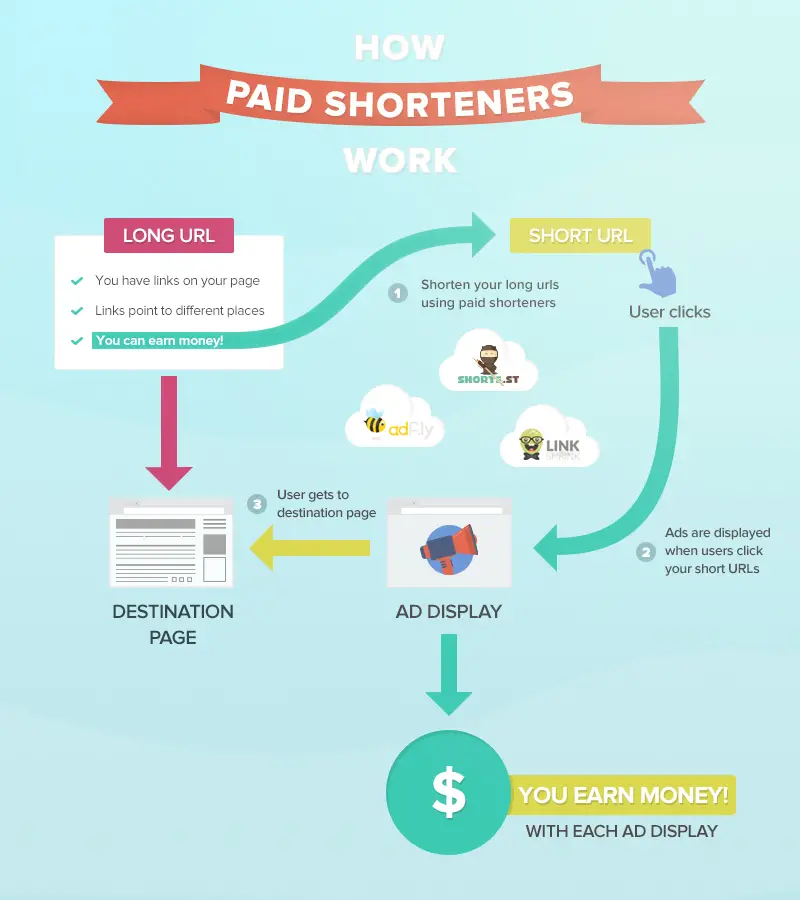
Another method of earning with link shortener services is their referral program, in which users earn extra when they introduce someone else to subscribe their service.
Although not all services provide this option, you are more likely to find it in the top-rated link shortening services.
Best paid Link Shorteners services (our pick)
There are numerous URL shortening services out in the open market and picking the best of the best isn’t an easy task.
While some of the most popular services are great, they don’t offer pay to their clients. For that reason, they do not make this list but if making money isn’t your immediate goal, you can always check them out.
All Link Shorteners on this list have been verified to make payments to clients although pay-out varies. Payment by some services is calculated based on revenue sharing while others are based on the number of clicks or on impressions.
Adfly
AdF.ly is the oldest and most likely the most trusted paying URL shortening service provider out there. Adf.ly pays its publishers $15.98 as the highest rate for traffic from the United States.
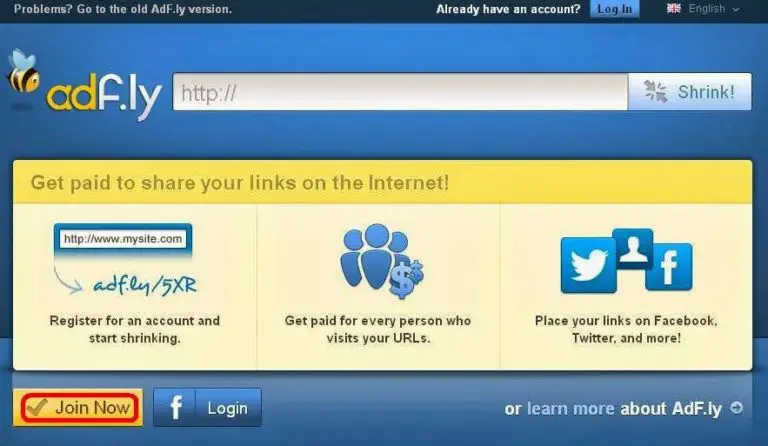
Payment is made on the 10th of each month, with a minimum withdrawal set at $5 for PayPal and $20 for Payoneer.
Moreover, short links are not the only way to get money with Adfly. For every new user, you refer, you will get 20% of their earnings.
The best part; Commission on Referrals is Lifetime long. That implies if your referee earns $200, $40 will be added to your adfly account.
Adfly is also well ranked on Alexa Global Ranking giving it a big boost in credibility and popularity.
Clk
Clk.sh is one of the more recent and best URL shorteners. It is a free tool. On Clk, advertisers have the ability to create custom banners and interstitial advertising campaigns.
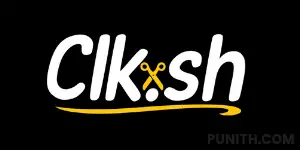
Furthermore, publishers can earn money to shorten and share shortened links online. Advantageously, it is one of the highest paying URL shorteners in 2021.
All you need to do is, just create an account, with Clk.sh, create a shorten link and share it anywhere online. You keep making money for every view or visit.
When you refer your friends to Clk, you earn 25% of their earnings for life as an affiliate commission. Awesome right!!
More features of Clk include:
- Controlling all features from the administration panel with a click of a button.
- Another factor that makes Clk.sh the best URL shortener is that publishers can check their Clk.sh shorten links performance. More so, advertisers can track their banner campaign and interstitial campaign performance.
- A low minimum payout limit to withdraw your earnings, set at just $5.00. And publishers get paid via PayPal.
- An offer of high CPM rates.
- Facility to shorten links using API.
- 24/7 customer support.
Shorte
Shorte.st is another noteworthy and popular URL Shortener to earn money. Just like Adfly, it also pays on the 10th of each month. Shorte has the highest payout of $14.04 for every 1000 views from the United States.

Shorte’s least withdrawal is set at $5 for PayPal, $20 for Payoneer, and $5 for WebMoney.
Shorte runs a referral program as well and for every referred user, you will get 20% of their earnings. As above, if your referee earns $100, $10 will be added to your shorte.st account.
Short
Short.am gives an excellent opportunity for making money by shortening links. It’s also one of the fastest-growing URL shortening websites available.
Simply join, shrink URLs and begin earning.
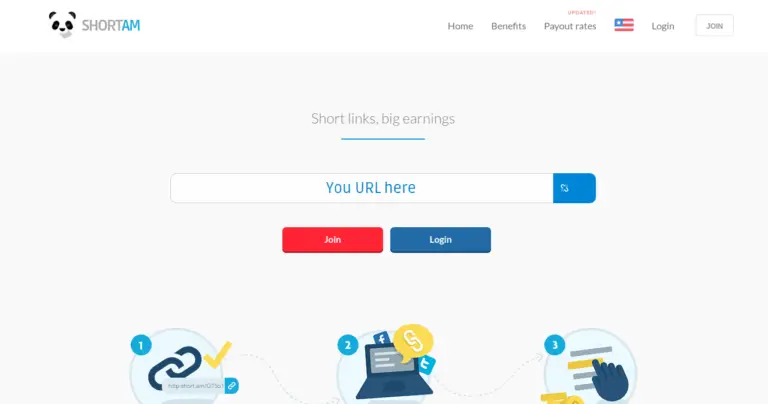
Short.am pays $2.50 as its highest rate for traffic from the United States. Added to link shrinking earnings, short.am provides extra add-ons and plugins so that you can monetize your WordPress site.
Generally, the minimum payout is set at $5. Users get their payments via PayPal or Payoneer.
Most importantly, it runs a referral program wherein you can get 20% more earnings for a lifetime.
For clarity of purpose, we are keeping this list as short as possible. That is not to say there aren’t other awesome links shortening services out there even, some with even better deals.
But those on this list have withstood the test of market challenges and time.
How to use Link Shortening Services
Step 1: The first step to using shortened URL links is to select a shortening service provider. We have given detailed explanations on how to select one and have listed a few of the best available providers in today’s market. Make a choice suitable to your business needs.
The next step is to register for your choices’ services. Using adf.ly as a case study, that process looks a lot like this.
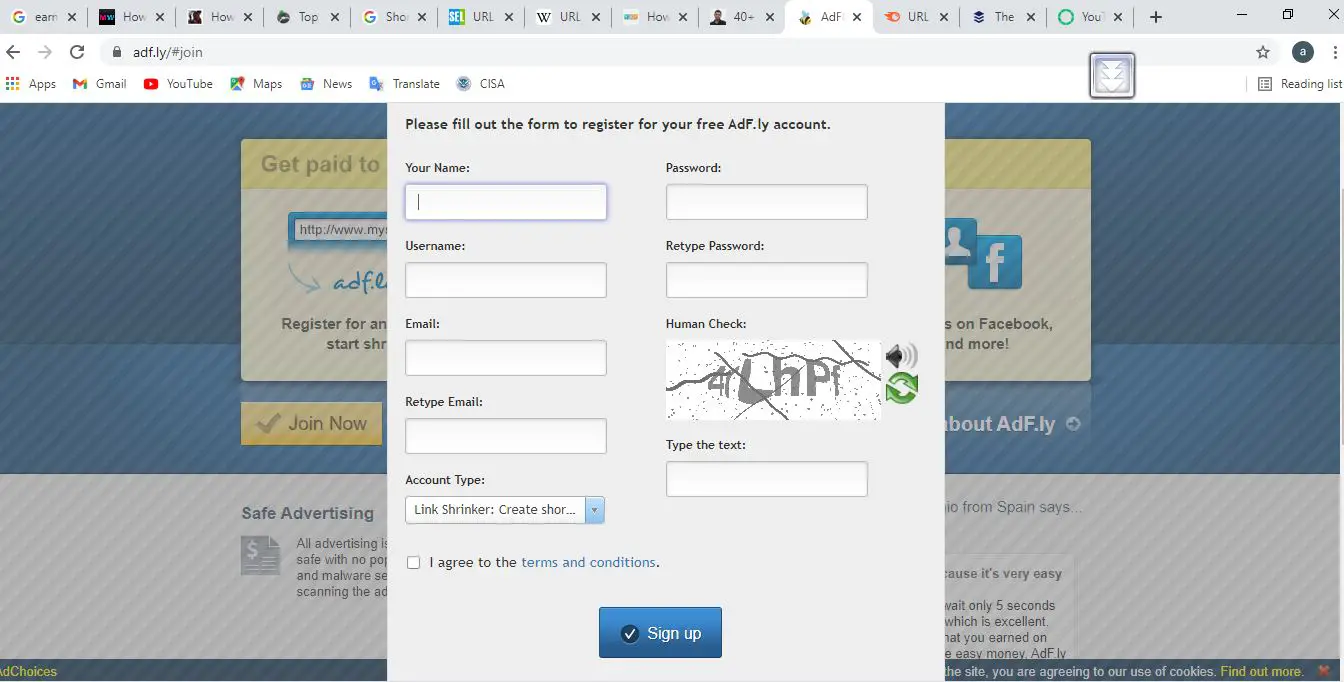
Fill the form, select create short links as the account type and click sign up.
Step2: login to your account on adf.ly and you have a dashboard showing all the properties of adf.ly service.
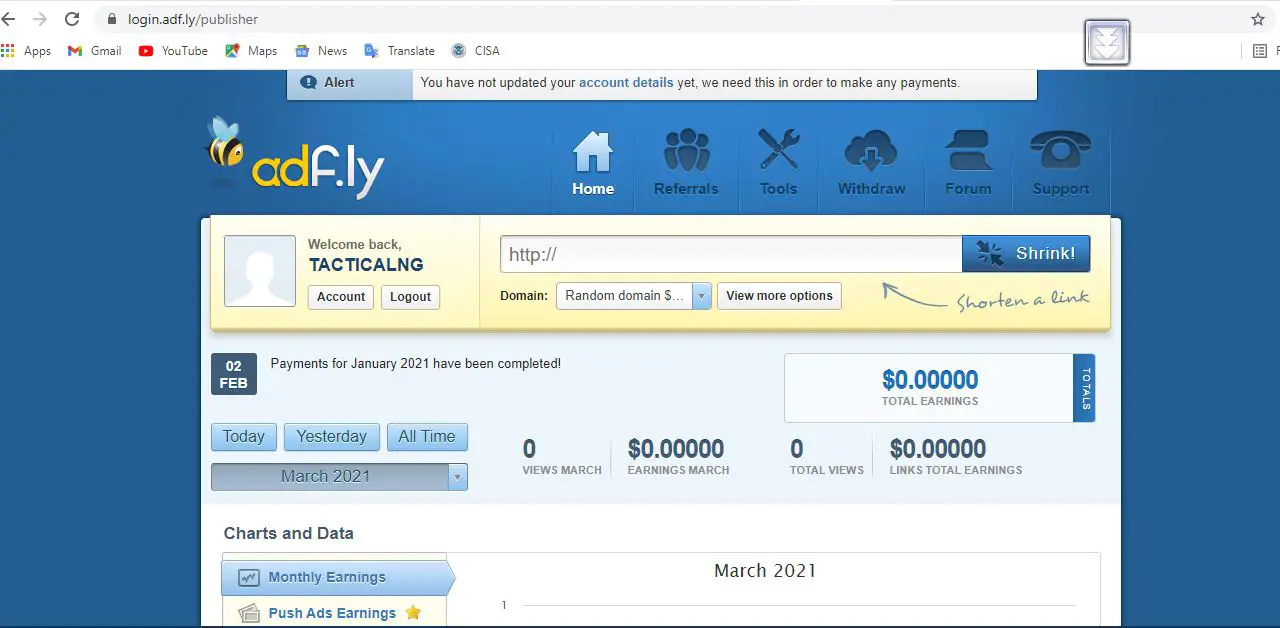
Step 3: start pasting links in the link bar and click shrink to shorten.

Then copy the shrunk link and share it on other platforms of your choice.

Other cool stuff you can do with adf.ly include a page for referrals which earns you more money
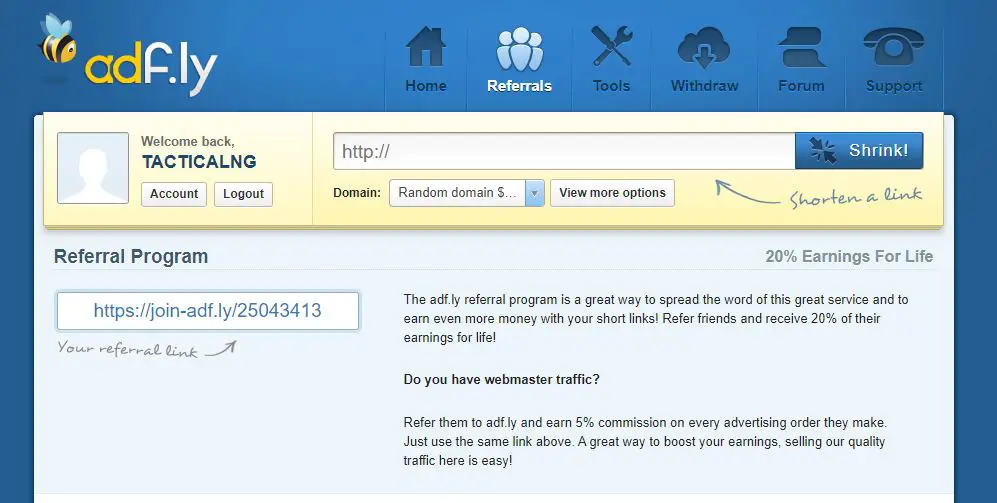
Adf.ly also has a page with awesome tools to ease your work.

Adf.ly has a great support system and an online forum where users can share views about the services rendered.
Depending on the services you end up using, payment rates and dates would vary. But basically, the process is similar on all platforms.
Conclusion
Link Shorteners basically use the process of taking a long website URL or address and directing it through a shorter and neater-looking link.
For website owners with a lot of generic traffic, link shortening has become a new source for generating revenue.
While Ads provided by link shortening services are a suitable means of earning extra cash, they shouldn’t be solely relied upon.
Service providers are prone to changing terms of agreement and operations frequently although it provides a suitable alternative to the likes of Google Adsense and others.
Be that as it may, it’s important to maximize all earning potentials online by making smart decisions and combinations. You can surely add Link Shorteners to your sources of income online.
Is there any aspect of link shortening that you feel we didn’t cover? Drop a comment and we will surely reply.






